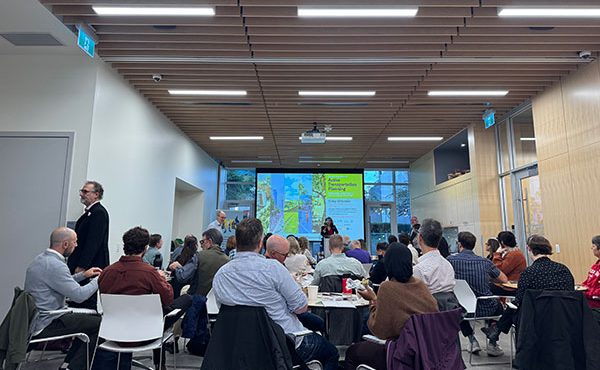

Edited by Kelty McKinnon; with contributions by Michael Van Valkenburgh, Ken Greenberg, Jacqueline Hucker, Dr. Eduard Koegel, Bruce Kuwabara, Kelty McKinnon, Douglas Paterson, and Julian Smith (Blueimprint, 2010)
“Phillips Farevaag Smallenberg are important pioneers in promoting a fundamental paradigm shift in the way that we design and build cities.” – Michael Van Valkenburgh in the foreword.
Phillips Farevaag Smallenberg (PFS) is a well-known Vancouver-based planning, urban design, and landscape architecture firm, whose work is introduced in their recently release book Grounded. Through seven thematic essays written by different design collaborators, the diverse group of planners, architects, designers, teachers, and historians tell their stories – illustrating twenty years’ work on fifty local and international projects with vivid graphics embedded in the text.
Senior PFS Landscape Architect Kelty McKinnon discusses the meaning of ‘ground’ as an abstract perspective. McKinnon states that “without architecture, landscape is illegible – its spatial qualities dependent on its circumscription.” It is a profound statement in an urban context, challenging the relationship between built form and the spaces in between (away from urban centres, however, banal suburbia and the regimented agricultural grid interfere more than accentuate). McKinnon argues that “ground” encompasses what lies above and below, and therefore is a three-dimensional spatial concept.
The social and historical commentary is strong throughout the book. Each of the seven essays – Landscape into Urbanism; Dynamic Alliances; Place, Body, Memory; Cultural Landscapes; Global Acculturation; Elysian Fields; and SuperNatural – focuses on the evolving role of landscape architecture in strengthening the ecological, social, and political ties in an ever-changing landscape. These are interspersed among a number of selected projects images, drawings, and descriptions.
In Landscape into Urbanism, renowned Canadian architect Bruce Kuwabara speaks to the renewal of “a livable civic community…predicated on a walkable, connected, and accessible public realm.” He presents the 21st century movement as a response to cities faced with population growth and urban sprawl. From suburbia to the compact city, Kuwabara discusses PFS projects that apply integrative design processes to resolve competing public/private ownerships in placemaking.
This is followed by Ken Greenberg‘s Dynamic Alliances within which he describes how “the environmental thrust…[gains] traction and broad popular appeal as a common ground which cuts across class, cultural, and political lines.” Furthermore, he observes the sharing of leadership out of necessity, crossing boundaries of engineering, science, and art. Although the search for environmental solutions invites greenwashing, Greenberg argues the potential risk is outweighed by the positive results of communities building toward lower impact lifestyles while simultaneously creating a sense of place.
Douglas Paterson, professor emeritus and former director of the Landscape Architecture Program at the University of British Columbia, tackles the meaning behind places and the importance of “particularness” in a world governed by global capitalism in Place, Body, Memory. As a solid advocate of place-based design, Paterson highlights the significance of explicitly focusing on the “particular ecologies, climates, and people with particular memories embodied in the local.”

A conversation between Chris Phillips, Marta Farevaag, and Greg Smallenberg is included halfway into the book serving as an intermission point and chance for readers to learn about the founders in a more personal way. McKinnon, as interviewer, creates a rather relaxed atmosphere and a back-and-forth dialogue.
Architect Julian Smith‘s essay Cultural Landscapes is the next in line discussing landscapes that are “not observable,” “mapped by ritual,” and “idea[s] embedded in place.” To him, places must be experienced to be understood, and he continues to describe the cultural exchange between two firms collaborating despite differing design philosophies.
Global Acculturation in China began “by learning from the best solutions and adapting them to local conditions.” This piece – written by urban planner, architect, and author, Dr. Eduard Koegel – urges foreign planners and designers to learn from their cultural misunderstandings of China and integrate their Western concepts through adaptation. Koegel provides an enriching discussion on the historical significance of the East exchanging ideas with the West, and fast-forwards to the present day pressure on cities to be models of sustainable urbanism.
Architectural historian Jacqueline Hucker searches for romanticism in the reappropriation of Canadian pastoral landscapes for nationalist and militarist ends in Elysian Fields where “the living [can] commune with the dead and find solace through the presence of nature.”
Grounded concludes with SuperNatural written by McKinnon – the voice of PFS in the text. She closes with the firm’s fixation with nature in Vancouver “as a kind of ‘learning from landscape’ – the formation of a sensibility to landscape that goes beyond scenic production.”
The deliberate selection of these respected contributors with distinct practices is representative of the broad scope of PFS and their collaborative efforts. On the surface, the multitude of glossy illustrations gives Grounded the appearance of promotional literature. But reading in more depth, it becomes clear that the firm is grounded (as the title suggests) in a dynamic design process of shaping neglected or underutilized land into active public spaces that embrace nature, be it in urban or rural settings.
Overall, the sequence of essays present the projects as showcase pieces – generally praising them, with occasional constructive criticism depending on the author. The book is held together by a thematic tapestry that reveals the underlying message – landscape is the basis of place and identity, recently recovered from a Modernist lapse.
Among progressive 21st century design firms, Phillips Farevaag Smallenberg are strident advocates for the importance of landscape architecture in bringing publicly-accessible nature into cities, even in the most exclusive landscapes.
***
Kathleen Corey likes tiny apartments over shops, hikes with panoramic city views, and flowing urban landscapes. While in the San Francisco Bay Area, she led design processes for the India Basin community farm and Wilkie Creek outdoor classroom. Kathleen completed the Urban Design certificate at SFU’s City Program and is working toward her Master of Landscape Architecture at the University of Guelph.



